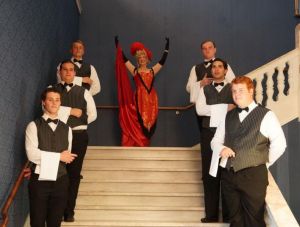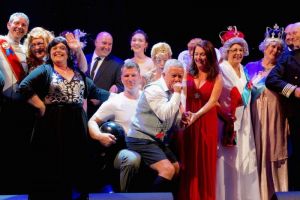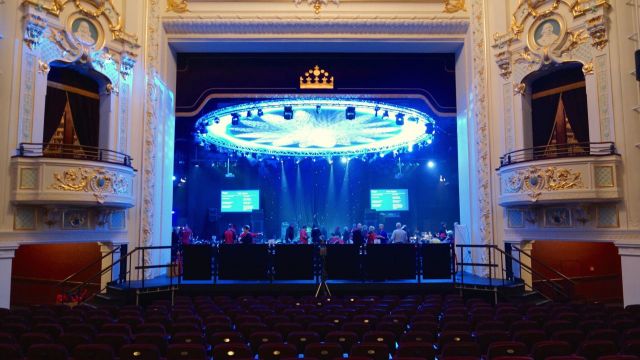Postcard From Christchurch
Theatre Jewel Amidst The Ruins.
As Christchurch slowly rebuilds after the devastating earthquakes of 2010 and 2011, its grand old lady is breathing back life into its theatrical soul. David Spicer trod the boards of the re-born Isaac Theatre Royal, which was the venue for the 55thMusical Theatre New Zealand weekend conference, party and AGM.
Moving around the centre of Christchurch on its historic tram is a little sad. The grand Cathedral is still in ruins, while there are numerous empty blocks and condemned buildings are sealed off waiting for the bulldozer.
Many structures up and runninghave elaborate murals. The town’s brothel/strip club sits conspicuously in an open field with a curled up naked lady painted on its side. But it was another lady I was pleased to see: the mural of the ballerina painted on the rear end of the newly restored Theatre Royal.
 When the second earthquake struck a number of workers were lucky to have left the stage just before the proscenium collapsed. The theatre trust then had to raise a fortune, forty million dollars or so, to put the theatre back together again.
When the second earthquake struck a number of workers were lucky to have left the stage just before the proscenium collapsed. The theatre trust then had to raise a fortune, forty million dollars or so, to put the theatre back together again.
They restored the façade, the foyer, the marble staircase and auditorium interior walls and ceiling. Everything else is modern.
There was lots to admire - the painted scenes from A Midsummer Night’s Dream on the dome, Shakespeare’s plaster bust above the Royal Box and gilding in every nook and cranny.
The visual treats are admired best from the highest balcony seats. This was an irony not lost on the Theatre Trust’s Dr Anna Crighton, who was keynote speaker at the conference.
When it opened in 1908 the privileged sat in the dress circle whilst poorer members of the general public sat up in the highest level of seats.
“To reach the Gods, patrons had to climb an exterior steel staircase – an area that was considered dangerously steep even at that time. Patrons did not sit on seats then but on benches,” she said.
A more egalitarian interior with seats for everyone was not constructed until 1928.
The conference was held on the stage, which felt like it stretched forever with a soaring fly tower above.
The local theatre company Showbiz Christchurch was itching to get back on stageproperly. It was a few weeks off its return with The Phantom of the Opera.
 An intriguing silver haired gentleman (who you can see on the video) gave me the inside story on the club when he picked me up at the airport. Years back the old Christchurch Operatic (as it was known then) gave all of its assets to a trust managed by some shrewd investors. The right investment in shares has secured its future big time. Lucky they didn’t the put the cash on the horses.
An intriguing silver haired gentleman (who you can see on the video) gave me the inside story on the club when he picked me up at the airport. Years back the old Christchurch Operatic (as it was known then) gave all of its assets to a trust managed by some shrewd investors. The right investment in shares has secured its future big time. Lucky they didn’t the put the cash on the horses.
Like many community theatres in New Zealand Showbiz Christchurch has good real estate. The club reluctantly gave up its former building due to earthquake re-zoning.
Thecompany gave us a tour of their new home base that cost upwards of 1.1 million dollars. We admired the shiny new rehearsal floors, sewing rooms, costume storage and plenty of places to lounge around.
The silvery haired gentleman was very pleased to show me a picture on the wall of him taken many decades previously, with his shirt taken off, as the strapping male lead in the popular operetta of the day.
The faces stare down from the walls, testament to a club that has been entertaining its community since 1938 and now appears indestructible.
The musical theatre conference is always a mixture of business and pleasure – the highlight is their annual fancy dress ball. Formal attire from any era was this year’s theme.
But having attended most conferences over the last twenty years there is no mistaking thatit is becoming a little more business than show.
 According to a survey MTNZ released, the top twenty productions of the previous year sold 135,000 tickets. Seven of the productions sold approximately 10,000 tickets or more. The big ones were seasons of Mamma Mia! and The Phantom of the Opera. 75% of shows make a profit and 20% lose money.
According to a survey MTNZ released, the top twenty productions of the previous year sold 135,000 tickets. Seven of the productions sold approximately 10,000 tickets or more. The big ones were seasons of Mamma Mia! and The Phantom of the Opera. 75% of shows make a profit and 20% lose money.
The large theatre companies pool resources to tour a set around the country.It means many people earn income out of community theatre.
Seventy percent of the groups pay their director and just over half pay musical directors and choreographers.One in ten companies also pay some members of the cast.
By and large it is an Anglo-Saxon affair. Almost ninety percent of cast and crew are European. Women outnumber men 58 percent to 42. And there was no surprise that young people dominate the on-stage roles, leaving the older ones back stage.
On every conference desk was placed a glossy brochure called Musical Theatre New Zealand Strategic Plan 2015-2020.There were all sorts of buzz words like “stakeholders”, “operational planning”, “financial sustainability” and “Educate, support and advocate”.
The only thing missing seemed to be lets have some fun putting on a show.
More Reading
Subscribe to our E-Newsletter, buy our latest print edition or find a Performing Arts book at Book Nook.




